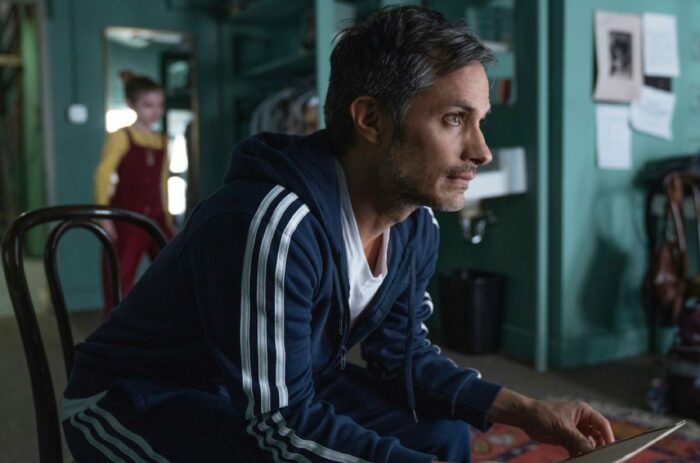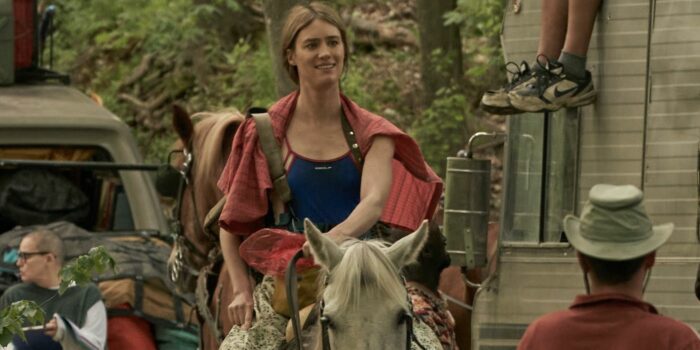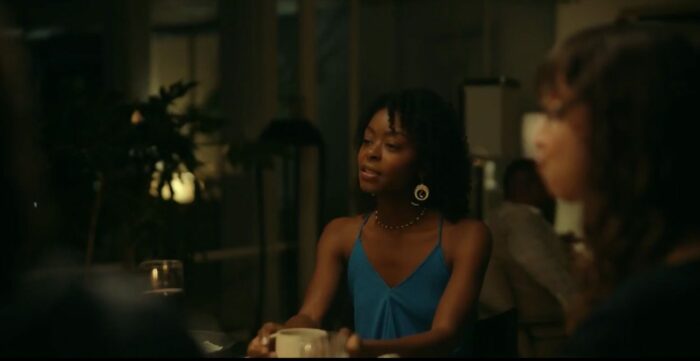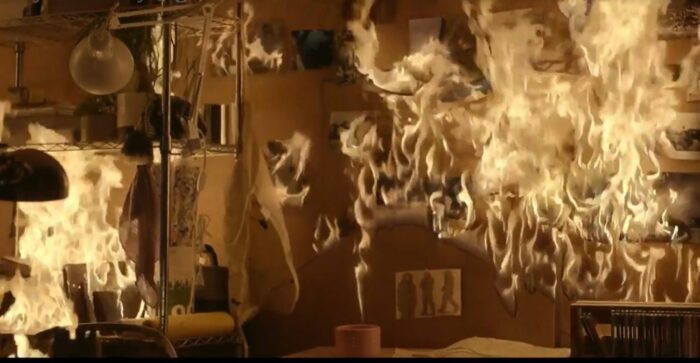The following contains spoilers for Station Eleven Episode 1, “Wheel of Fire” (written by Patrick Somerville and directed by Hiro Murai) Episode 2, “A Hawk From a Handsaw” (written by Patrick Somerville and directed by Jeremy Podeswa), and Episode 3, “Hurricane” (written by Shannon Houston and directed by Hiro Murai)
Station Eleven, the new HBO Max limited-run series, is not a post-apocalyptic show. Sure, it centers around a world-shattering flu that kills the vast majority of the world’s population, but it always aspires to be something more. While the pandemic is central to the plot and to the lives of the characters—even those that don’t survive long enough to see it happen—the true value of the series, and the novel by Emily St. John Mandell upon which it is based, lies in an exploration of how culture and art are adapted by, and help to mold the narrative of, tragedy.
There is a genuine sense of belonging to community and a celebration of life throughout Station Eleven that is missing from almost every other show like this. That is what makes it so compelling. Rather than being a meditation on death, the focus is on art and how, by making art, we can become free from death. There are various ways that Station Eleven, the series, tackles these connective threads, but the clearest is evident from the way the show starts: an actor dying on stage, completely unrelated to the coming apocalypse.
Episode 1: “Wheel of Fire”
Station Eleven Episode 1, “Wheel of Fire” takes us to the stage, and the acclaimed film actor Arthur Leander (Gael Garcia Bernal) on stage as King Lear. Leander suffers a heart attack and dies during the show, and more than that he is the central focal point around which all of the other characters revolve. It is pivotal to the story that Leander was playing Lear—his flaws may not have led directly to his demise but they are on full display, but so is his humanity and capacity to love. A film actor, brought in more for his fame than his fit for the role, Leander is far too young to play King Lear. But his youth adds to the sense of tragedy around his death and Garcia Bernal is able to give Leander depth and a real sense of grounded purpose in a short time.

It turns out that this man is mentor, father, lover, and friend to four of the other main characters. And while Arthur Leander isn’t present for most of the work—his death opens both the book and the show—it is clear that he has a huge impact on all of them. His death creates emotional, symbolic, and philosophical developments within each of those characters. The true significance that Leander holds for the story plays out very slowly. It is unwrapped bit by bit over time and chapters and episodes until we finally get a sense of the man, and the significance that one death can hold. Even if it is an immediate precursor to billions more deaths.
Jeevan Chaudhary (Himesh Patel) is in the audience and seems to be the only person to notice Leander is struggling. He rushes the stage in a sense of panic and desperation to do something, only to be pushed aside, helpless, as the man dies. Jeevan is a type of character who can sometimes be a problem in these stories. He is a young slacker, unemployed and directionless, who wants to do the right thing but is unable or willing to do so. But Jeevan starts to subvert expectations almost immediately. After he fails to help Leander he notices young Kirsten Raymond (Matilda Lawler) distraught and alone, taking in the horrifying scene. Jeevan immediately takes Kirsten under his wing, unknowingly sealing them both together for the end of the world.
Photo: HBO MaxThe two become inextricably attached over the course of the night. This and the speed of the onset of the deaths are the main significant departures from the book that I have noticed so far. (Other than the change of the main settings from Toronto to Chicago.) I think I preferred the way the disease spread much more realistically in the book. It took weeks before the entire world shut down, whereas in the show the effects are immediately felt, but do linger. But I can understand that would have both been difficult to dramatize and also, perhaps, a bit too “real”. Putting Jeevan and Kirsten together though was definitely the right thing to do.
As the pair make their way first to Kirsten’s house and then to Jeevan’s brother Frank’s (Nabhaan Rizwan) palatial apartment, they have to navigate the increasingly fragmented world around them. This is exacerbated by their own, very real feeling, character flaws and quirks. Jeevan suffers panic attacks and is terrible with people. Kirsten is aloof and precocious, unable to connect to people and profoundly lost in this breaking world. Patel and Lawler are both really strong at playing the conflicting inner emotions of these two people in very different life spaces, now thrown together.
When Jeevan finally lies to Kirsten and tells her that he spoke to her parents and they said she could stay with him, the pain shows clearly on Patel’s face. He knows he has done the right thing, but that it also means uncertainty and ambiguity. Later when Kirsten, after days of trying to reach her mother on the phone, hears “the owner of the phone is dead, don’t come here” her pain becomes palpable.
Nothing that had happened since the death of Arthur had really made sense to Kirsten, but now she knew that both her parents and the man she most admired were dead, and Lawler portrays the grief and intensity with a ferocity not often found in child actors. (Lawler looks quite a bit like a young Kiernan Shipka, and the potential for this to be a similar breakout for her as Mad Men was for Shipka seems quite high.)
Episode 2, “A Hawk From a Handsaw”
For Episode 2, “A Hawk From a Handsaw” Station Eleven spends most of the time set 20 years into the future with the focus shifted to an adult Kirsten, now played by Mackenzie Davis. Kirsten travels the “circuit” with the Travelling Symphony—a collection of artists and performers who play music and perform shows in the small villages that have popped up around the Great Lakes. These chapters were the ones that most affected me when I read Mandell’s novel. The idea of life and love and art transcending tragedy seems to be most at play when following the Symphony.

The world of the Symphony is completely different than they used to know, but the thing that is so compelling about the time-jump is that the new world feels lived in. The people have adjusted to it, and many of them have never known anything else. Kirsten is hard and direct, compulsive about the art and the idea of art still being important, but also willing to reminisce with the Conductor (Lori Petty) and others about the world as it was, and the ways they can try to keep the spirit alive.
Unfortunately, this world is also just as dark, dangerous, and foreboding as you might expect. Death and evil lurks everywhere and so the whole troupe only trusts those they know. Kirsten is defined and warped by her pains. We don’t yet know what happened to separate her from Jeevan, but she has become a woman alone in the world before she joins the Symphony. It becomes her family and her way to put herself into a world. She is a great actress, partially because she is so able to tap into her interior pains and struggles. We get a good display of how brutal Kirsten can be in this world as she stabs a visitor who lies to them and leaves him for dead. (Unfortunately for Kirsten and the Symphony, he is definitely not dead.)
Episode 3, “Hurricane”
Episode 3, “Hurricane” moves back to the onset of flu, and before it, as we learn about Miranda Carrol (Danielle Deadwyler). She is the creator of the Station Eleven graphic novel that is both totem and inspiration to several characters in the show. She is also Arthur Leander’s ex-wife. The focus here is split between their relationship and her attempts to escape Malaysia at the outbreak of the virus. Carrol is an intense character, and an amazing creation. As we follow her we see her genius and her capacity for self-destruction both in full bloom.

A particularly memorable line from the graphic novel, “I remember damage,” is a recurring motif in that work, in the book, and in the TV series. These characters are shaped by the damage and tragedies that they have faced. They remember it, but they are not defined by it. Somehow Miranda Carrol encapsulated the weariness and brokenness of survival, before there was anything that had to be survived. Danielle Deadwyler plays Carrol with with a terrific, precise performance. Miranda is a woman clearly on edge at all times. She has been hurt, and she remembers everything.
But she channels that pain, first into her job working logistics, and later into her work on the comic. She draws and creates not for the public—her plan was never to publish Station Eleven—but for the value of the creation itself. Her marriage with Arthur Leander falls apart, for all the various reasons that such things happen. But the two of them are intensely bonded to each other and to the painful reality that is expressed through their devotion to their respective arts. When Carrol leaves Arthur after discovering he is sleeping with their friend, and even worse that he has shared her work with her, she burns down the pool house containing all of her work on Station Eleven.

Station Eleven works so well in part because it remembers that no matter how tragic life becomes, no matter how absolute the pandemic, it is individual moments and people that matter. And that no matter how sad and dark the story, there is still life, love and humor to shine through. It isn’t a work, either in the book or the show, of mere survival. As the museum of civilization also embodies, the story is about the survival of the entire culture.
In the last scene of “Hurricane” Miranda has sealed herself into her hotel room, hoping to avoid the spreading disaster to which we already expect she has been exposed. When there is a knock on the door, she goes to open it and in steps Dr. Eleven, a character from her Station Eleven graphic novel. When the spaceman comes to Miranda’s room it changes the tone, taking us into a different atmosphere. We zoom out from Miranda, and the look on her face is that of a woman on the brink of something very different. The time has come to go on a different journey.
Just like Miranda and her work, Station Eleven is full of uncertain moments and a general feeling of dread but ultimately it leaves us all with a sense of wonder at our ability to move on and continue to create great art, no matter how terrible the world has become. It felt as though this might be the wrong time to air an adaptation of Station Eleven but now having seen it the show seems to be a perfect reminder of the power of stories, and so it may actually be the perfect show to guide us through the current era.

